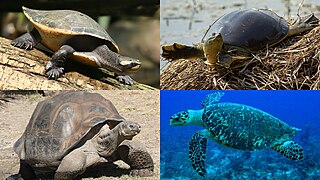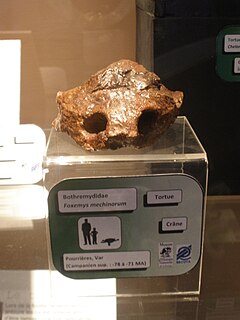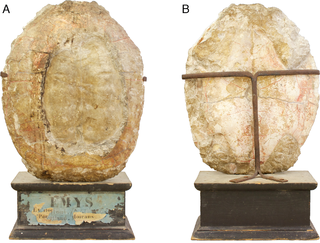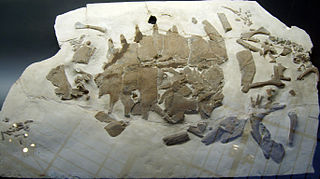
Reptiles, as most commonly defined, are the animals in the class Reptilia, a paraphyletic grouping comprising all amniotes except synapsids and Aves (birds). Living reptiles comprise turtles, crocodilians, squamates and rhynchocephalians (tuatara). In the traditional Linnaean classification system, birds are considered a separate class to reptiles. However, crocodilians are more closely related to birds than they are to other living reptiles, and so modern cladistic classification systems include birds within Reptilia, redefining the term as a clade. Other cladistic definitions abandon the term reptile altogether in favor of the clade Sauropsida, which refers to all animals more closely related to modern reptiles than to mammals. The study of the traditional reptile orders, historically combined with that of modern amphibians, is called herpetology.

Turtles are an order of reptiles known as Testudines, characterized by a shell developed mainly from their ribs. Modern turtles are divided into two major groups, the side-necked turtles and hidden neck turtles which differ in the way the head retracts. There are 360 living and recently extinct species of turtles, including tortoises and terrapins. They are found on most continents, some islands and much of the ocean. Like other reptiles, birds, and mammals, they breathe air and do not lay eggs underwater, although many species live in or around water. Genetic evidence typically places them in close relation to crocodilians and birds.

Teenage Mutant Ninja Turtles, also known as Teenage Mutant Hero Turtles, is an entertainment franchise created in 1983 by American comic book authors Peter Laird and Kevin Eastman. It follows Leonardo, Raphael, Donatello and Michelangelo, four anthropomorphic turtle brothers trained in ninjitsu who fight evil in New York City.

Little Turtle was a Sagamore (chief) of the Miami people, who became one of the most famous Native American military leaders. Historian Wiley Sword calls him "perhaps the most capable Indian leader then in the Northwest Territory," although he later signed several treaties ceding land, which caused him to lose his leader status during the battles which became a prelude to the War of 1812. In the 1790s, Mihšihkinaahkwa led a confederation of native warriors to several major victories against U.S. forces in the Northwest Indian Wars, sometimes called "Little Turtle's War", particularly St. Clair's defeat in 1791, wherein the confederation defeated General Arthur St. Clair, who lost 900 men in the most decisive loss by the U.S. Army against Native American forces.

Sea turtles, sometimes called marine turtles, are reptiles of the order Testudines and of the suborder Cryptodira. The seven existing species of sea turtles are the green sea turtle, loggerhead sea turtle, Kemp's ridley sea turtle, olive ridley sea turtle, hawksbill sea turtle, flatback sea turtle, and leatherback sea turtle. All six of the sea turtle species present in US waters are listed as endangered and/or threatened under the Endangered Species Act. The seventh sea turtle species is the Flatback, which exists in the waters of Australia, Papua New Guinea and Indonesia. Sea turtles can be separated into the categories of hard-shelled (cheloniid) and leathery-shelled (dermochelyid). There is only one dermochelyid species which is the leatherback sea turtle.

The European turtle dove is a member of the bird family Columbidae, the doves and pigeons. It breeds over a wide area of the south western Palearctic including north Africa but migrates to northern sub-Saharan Africa to winter.

The leatherback sea turtle, sometimes called the lute turtle or leathery turtle or simply the luth, is the largest of all living turtles and the heaviest non-crocodilian reptile, reaching lengths of up to 2 metres and weights of 600 kg. It is the only living species in the genus Dermochelys and family Dermochelyidae. It can easily be differentiated from other modern sea turtles by its lack of a bony shell; instead, its carapace is covered by oily flesh and flexible, leather-like skin, for which it is named.

Podocnemididae is a family of pleurodire (side-necked) turtles, once widely distributed. Most of its 20 genera and 30 species are now extinct. Seven of its eight surviving species are native to South America: the genus Peltocephalus, with only one species ; and the genus Podocnemis, with six living species of South American side-necked river turtles. There is also one genus native to Madagascar: Erymnochelys, the Madagascan big-headed turtle, whose single species E. madagascariensis.

The mata mata, mata-mata, or matamata is a freshwater turtle species found in South America, primarily in the Amazon and Orinoco basins. It is one of two extant species in the genus Chelus, the other being Chelus orinocensis.

Teenage Mutant Ninja Turtles is an American animated television series produced by Murakami-Wolf-Swenson and the French company IDDH Groupe. It was the first television adaptation of the Teenage Mutant Ninja Turtles comic books by Kevin Eastman and Peter Laird.

The green sea turtle, also known as the green turtle, black (sea) turtle or Pacific green turtle, is a species of large sea turtle of the family Cheloniidae. It is the only species in the genus Chelonia. Its range extends throughout tropical and subtropical seas around the world, with two distinct populations in the Atlantic and Pacific Oceans, but it is also found in the Indian Ocean. The common name refers to the usually green fat found beneath its carapace, not to the color of its carapace, which is olive to black.

The Dream of the Blue Turtles is the first solo album by English musician Sting, released in the United States on 1 June 1985. The album reached number three on the UK Albums Chart and number two on the US Billboard 200.

Turtle soup is a soup or stew made from the meat of turtles. Differing versions of the soup exist in some cultures and are viewed as a delicacy.

The twist-necked turtle also known as the flat-headed turtle, is distributed widely across northern South America. Twistoofnecked turtles have extremely flat shells that help them hide from predators under rocks and debris. When threatened, this turtle withdraws by twisting its head into its shell. P. platycephala is the only species of the genus Platemys and occurs in northern and central South America. Platemys platycephala means “flat turtle, flat-head” and accurately describes the structure of the head and shell. This species inhabits shallow creek beds and frequently forages on the floor of the Amazon rainforest for insects, amphibians, and mollusks. Camouflage, head and body shape, and advanced sexual anatomy allow this species of turtle to effectively populate much of South America. Mating occurs during rainy months (March–December) and egg deposit occurs during dry months (January–March). Males have been known to behave aggressively towards females during copulation by squirting water from nostrils and biting. A few genomic studies show mosaicism exists among populations of the twist-necked turtle in Surinam. In other words, diploid and triploid levels exist among individuals at this particular location. No threats have been reported for this species and the International Union for Conservation of Nature does not have a current listing. Lack of human consumption due to the species' small size and its wide range explain why scientists are not concerned about this turtle species.

The hawksbill sea turtle is a critically endangered sea turtle belonging to the family Cheloniidae. It is the only extant species in the genus Eretmochelys. The species has a worldwide distribution, with Atlantic and Indo-Pacific subspecies—E. i. imbricata and E. i. bissa, respectively.

Eurysternum is an extinct genus of thalassochelydian turtle. Its type species is Eurysternum wagleri, the holotype of which has since been lost and only survives in illustrations.
Compsemys is an extinct genus of prehistoric turtles from the Late Cretaceous and Paleocene of North America and possibly Europe. The type species C. victa, first described by Joseph Leidy from the Hell Creek Formation in Montana in 1856., and another probable species C. Russelli, described in 2012, from Paleocene deposits in France. Its affinites have long been uncertain, but it has recently been considered to be the most basal member of Paracryptodira, despite the clade first appearing in the Late Jurassic, and is sometimes included in its own family, Compsemydidae. A revision in 2020 found Compsemydidae to be more expansive, also containing Riodevemys and Selenemys from the Late Jurassic of Europe, and Peltochelys from the Early Cretaceous of Europe.

Foxemys is an extinct genus of bothremydid turtle that was discovered at Fox Amphoux, France and also Hungary and Spain. Its skull and shell structure is similar to Polysternon. Two species are in the genus: F. mechinorum and F. trabanti.

Plesiochelys is a genus of late Jurassic European and Asian turtle. The type species is Plesiochelys etalloni.

Eurysternidae is an extinct family of turtles in the clade Thalassochelydia. It consists of several genera of marine turtles from marine deposits in Europe, including Achelonia, Chelonides, Eurysternum. Hydropelta, Chelonides, Idiochelys, Palaeomedusa, Parachelys. and Solnhofia.




















